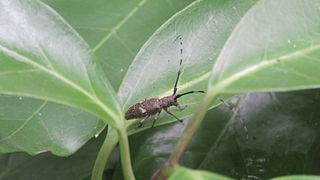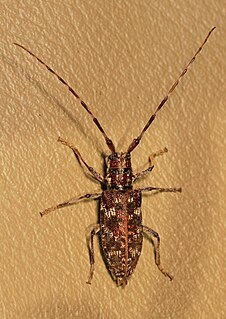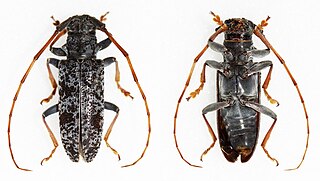
Monochamus is a genus of longhorn beetles found throughout the world. They are commonly known as sawyer beetles or sawyers, as their larvae bore into dead or dying trees, especially conifers such as pines. They are the type genus of the Monochamini, a tribe in the huge long-horned beetle subfamily Lamiinae, but typically included in the Lamiini today.
Niceforonia nigrovittata is a species of frog in the family Craugastoridae found in Colombia, Ecuador, Peru, and possibly Brazil. Its natural habitats are subtropical or tropical moist lowland forests and heavily degraded former forests.
The black-striped squirrel is a species of rodent in the family Sciuridae. It is found throughout Java, Sumatra, southern Thailand, the Malay Peninsula, and numerous small islands. This taxon consists of four subspecies: C. n. nigrovittatus, C. n. bilimitatus, C. n. bocki, and C. n. klossi. It is listed as "least concern" by the IUCN.

Tabanus nigrovittatus, also known as the greenhead horse fly, salt marsh greenhead, or simply the greenhead fly, greenhead or greenfly, is a species of biting horse-fly commonly found around coastal marshes of the Eastern United States. The biting females are a considerable pest to both humans and animals while they seek a source of blood protein to produce additional eggs. Females live for three to four weeks and may lay about 100 to 200 eggs per blood meal.

Monochamus scutellatus, commonly known as the white-spotted sawyer or spruce sawyer or spruce bug, is a common wood-boring beetle found throughout North America. It is a species native to North America.
Spilarctia nigrovittatus is a moth in the family Erebidae. It was described by Shōnen Matsumura in 1911. It is found in Taiwan.

Monochamus dubius is a species of beetle in the family Cerambycidae. It was described by Charles Joseph Gahan in 1894. It is known from India, Thailand, Myanmar, Vietnam, Taiwan, and China.
Eupromus nigrovittatus is a species of beetle in the family Cerambycidae. It was described by Maurice Pic in 1930. It is known from Vietnam and China. It feeds on Cinnamomum camphora and Tectona grandis.

Monochamus subfasciatus is a species of beetle in the family Cerambycidae. It was described by Henry Walter Bates in 1873. It is recorded from Japan where it infests Japanese red pine and is a vector of the nematode Bursaphelenchus doui.
Monochamus adamitus is a species of beetle in the family Cerambycidae. It was described by James Thomson in 1857. It is known from Tanzania, Sierra Leone, Angola, Ghana, Mozambique, the Ivory Coast, Senegal, the Democratic Republic of the Congo, Malawi, and Zimbabwe.

Monochamus sutor is a species of beetle in the family Cerambycidae. It was described by Carl Linnaeus in 1758, originally under the genus Cerambyx. It has a wide, natural distribution throughout Europe, and has also been introduced into Belgium and the Netherlands. Adults measure between 15 to 24 mm, and larvae measure up to 45 mm (1.8 in).

The spotted pine sawyer is a species of beetle in the family Cerambycidae. It was described by John Lawrence LeConte in 1852.

Monochamus galloprovincialis, the pine sawyer beetle, also referred to as the black pine sawyer beetle, is a species of beetle in the family Cerambycidae. It was described by Olivier in 1795, originally under the genus Cerambyx. It has a wide distribution, occurring naturally throughout Europe and the Caucasus. It has also been introduced into the Canary Islands. It serves as a vector for the parasitic nematode species Bursaphelenchus xylophilus, and also acts as a host to the parasitoid wasp species Dolichomitus tuberculatus.

Monochamus irrorator is a species of beetle in the family Cerambycidae. It was described by Chevrolat in 1855, originally apelled as "Monohammus" irrorator. It is known from the Republic of the Congo and Nigeria.
Monochamus leuconotus is a species of beetle in the family Cerambycidae. It was described by Francis Polkinghorne Pascoe in 1869, originally under the genus Anthores. It is known from Tanzania, Cameroon, Malawi, Kenya, Mozambique, Namibia, South Africa, Uganda, the Democratic Republic of the Congo, Zambia, Angola, and Zimbabwe. It feeds on Coffea arabica.
Monochamus ruspator is a species of beetle in the family Cerambycidae. It was described by Johan Christian Fabricius in 1781, originally under the genus Lamia. It has a wide distribution throughout Africa.

Monochamus sartor is a species of beetle in the family Cerambycidae. It was described by Johan Christian Fabricius in 1787, originally under the genus Lamia. It is known from throughout Europe, as well as in Kazakhstan, Mongolia, North Korea and South Korea. It is rated by the IUCN as Least Concern.

Monochamus spectabilis is a species of beetle in the family Cerambycidae. It was described by Perroud in 1855, originally under the genus Lophoptera. It has a wide distribution throughout Africa. It contains the varietas Monochamus spectabilis var. immaculipennis.
Monochamus thomsoni is a species of beetle in the family Cerambycidae. It was described by Chevrolat in 1855, originally under the genus Monohammus. It has a wide distribution throughout Africa. It contains the varietas Monochamus thomsoni var. buea.
Neolissochilus nigrovittatus is a species of cyprinid in the genus Neolissochilus. It inhabits Myanmar and Thailand and has a maximum length of 13.0 centimetres (5.1 in).










